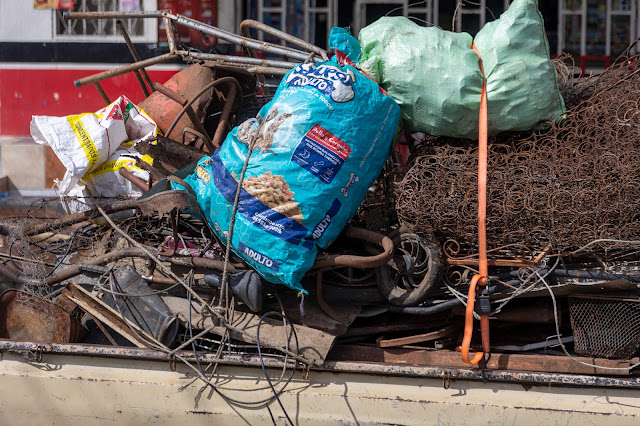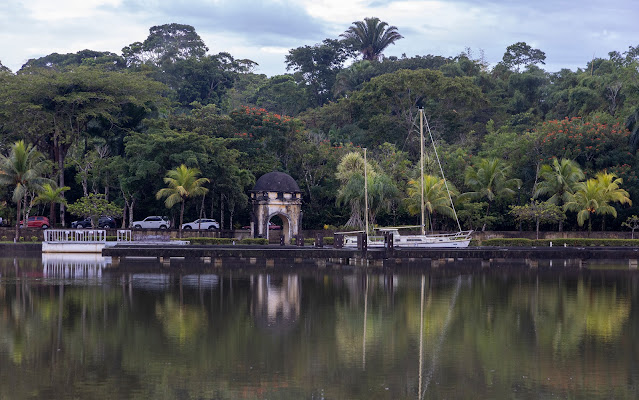Well that was our time in Honduras, blink and you'd miss it! Today's drive is 1 hour back to the border, 3 hours to Quiriguá, another archaeological site, and then a further 2 hours to our overnight stop near Puerto Barrios, which totals 6 hours. Conveniently I feel, and not for the first time, only part of the journey (3 hours) is timed in the brochure and in my opinion this is deliberate as many people could be put off taking this tour if the real journey times were laid out for them. We'd done our own research so knew what we were letting ourselves in for but others were unpleasantly surprised at yet another long day on the bus. When we got home I raised the issue with VJV as part of my extensive feedback and this was their response "My product team is looking into all of your feedback regarding the itinerary and travel times advertised on our website and in our brochure. We do feel it is important that this information is accurate so thank you for highlighting this to us." Mmmmmmm, we shall see - I'll be keeping an eye open on their future literature.
Emilio is very excited that we're overnighting in Puerto Barrios as he lives there. It's the first time the area has been included in a tour of this kind and as well as being very proud of his home town, he'll also be able to go home and see his family. This is his first tour since Covid and he's struggling a bit with being away from his young children for so long.
We enjoyed a short lie in this morning and after another very good breakfast (I'm so pleased I can order yemas fritas and be confident of getting just what I want; the chef this morning said it was a first for him, fried whites are very common but he'd never been asked for fried yolks) we left about 0900. I didn't take any pictures en route to El Florido border post but here are a couple whilst we waited for the one of the others who'd had to go back inside as for some reason she only exited Honduras and didn't enter Guatemala. We were surprised that having been behind us in the first queue she was back on the bus before us, but her husband didn't seem too bothered!
I snapped a few as we sped along so probably rather out of focus.
Cattle ranching is very big business in this area.
All these conical hills you see were once volcanoes.
I'm not entirely convinced that these "trees" weren't about to suddenly start walking - there's something distinctly Tolkienesque about them!
We drove past quite a few of these trees laden with hanging fruit and finally I got one in focus and could ask Emilio. Crescentia cujete (Calabash Tree) - known as the miracle fruit because of its medicinal properties. It contains vitamin B1, vitamin C, calcium, iron, sodium and potassium and the pulp apparently is very efficient in dealing with respiratory problems such as asthma and cough.
Just small oranges and rambutans for sale but very attractively displayed.
Or for those with a sweeter tooth - cakes and biscuits.
My fascination with the long vehicles continues, this is through the bus window. I wondered for a moment whether converging verticals were causing the lean on the telegraph pole but as nothing else is affected I think it must be how it stands.
Having fun in the sunshine.
We then drove through banana plantation country.
The practice of wrapping the ripening fruit in plastic is a Guatemalan innovation dating back to the 1950s and various colours have been tested (pink, green, blue, white and black) as well as transparent. The colour acts as a filter of photosynthetically active radiation (PAR), the wavelengths
between 400 and 700 nm that are used during photosynthesis. Blue covers let in 73% of the
wavelengths in the PAR (transparent ones let in 93%), thus producing heavier bunches by letting in the heat but blocking the UV rays which can cause burns.
Unfortunately by the time we reached Quiriguá it was drizzling and the skies were flat grey.
Quiriguá is a medium-sized site which during the Maya
Classic Period (AD 200–900) was situated at the juncture of several
important trade routes. Its history
it is closely entwined with Copán’s and its rapid expansion was linked to the
defeat and capture of Copán's King 18-Rabbit who was actually sacrificed in the great plaza
here
Another thing that makes this site so important is the wealth of sculpture, including the tallest stone monumental sculpture ever erected in the New World, made possible by the harder rock in the area.
I tried very hard to be interested and to follow what Emilio was telling us but my glasses kept getting covered in raindrops and steaming up and I probably concentrated more on not stepping in puddles.
Here are a few of the stelae.
The tallest stelae of all Maya monuments, stands 8m above ground level and 3m below - unfortunately I don't think it's this one and I didn't take a close-up of the other tall one.
This is the largest of all zoomorphs (what a great word, apparently it means a representation of something in animal form) and an
exceptional work of art (or so it said on the legend beside it). Not sure which side we're looking at here but on one the ruler is seen sitting inside the jaws of a mythological animal holding a mannequin scepter and a shield and, on the other face, a mythological monster is depicted.
This tree was quite magnificent.
Walking along one path I was thrilled to spot a long chain of leaf cutter ants.
And consequently I got left behind as I spent a long time trying to get a perfect shot.
The Caribbean side of the country is more humid and considerably wetter, which I suppose I should have expected. We didn't go into Puerto Barrios itself but driving through the outskirts it seemed quite industrial and perhaps a large container port.
A couple more large trucks for my collection not to mention badly placed distractions (I've still not worked out if there is a delay on the shutter or if I'm just slow to react!)
We're staying tonight at the Amatique Bay Resort hotel which is a rather sprawling 4* complex geared towards families I should imagine. The accommodation is adequate, 4 to each little building which are well spaced out in the grounds, in fact so well spaced out we have about a 15 min walk to the restaurant.
Emilio said that tonight there is a famous singer performing an open air concert in the grounds which his mum is actually attending. But it's the other side of the lake to the restaurant and accommodations and should finish around 2300, so hopefully we won't be disturbed.
With all these lovely old buildings we imagined it was a former plantation or something but in fact they're not old at all. The pool/restaurant area borders the Caribbean and features a pirate ship and other odd bits.
It had stopped raining by now and although the sun was trying to break through, as it was already about 1800 it would soon be setting.
Finally, a bird - a Great Kiskadee if I'm not mistaken
This pier was lovely but unfortunately following hurricane damage a few years ago it was blocked off halfway along.
Walking past the tower I could see numerous birds coming in to roost on the trees; herons, cormorants, pelicans and a few egrets. I'd only taken my short lens to the restaurant so decided to go back to the room to get the longer lens, forgetting quite how far it was. I saw what I thought was a shortcut across the grass and past the grazing ponies (don't ask) but in fact there was a water course running through the middle and it was very wet underfoot. By the time I got back there was just one bird in sight, this egret far away in the trees.
Ian said a family had walked the same path and instead of keeping well back so not to disturb the birds had walked as close as possible, mobile phone in hand, and scared most things away. Never mind, we enjoyed a bottle of wine and then a pleasant meal and watched the sun go down.
























































